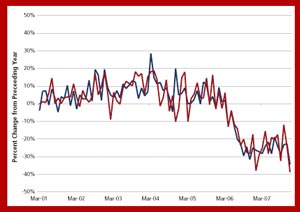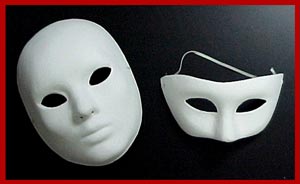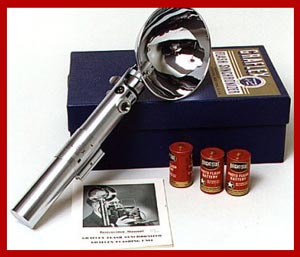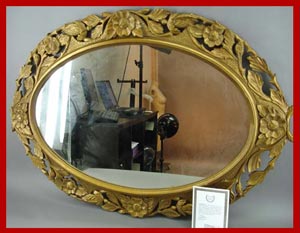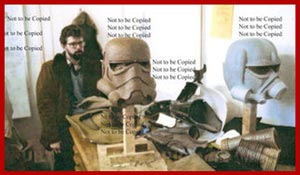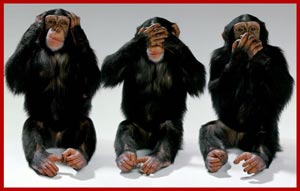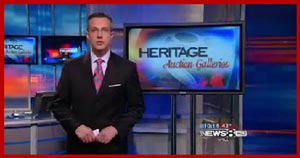As was the case last year (see 2007 Year in Review), what follows is an editorial review of my personal views with regards to the hobby, looking back at the top trends and news stories of 2008. As always, there were a lot of interesting developments and events, and quite a bit to review and consider.
What follows are my personal opinions, observations, and a subjective analysis of top news stories and trends from 2008.
10. The Economy & The State of The Original Prop Marketplace
One of the top news stories of the year in the mainstream media has been the downturn of the global economy.
Given the ongoing struggles of both individuals and companies, one outstanding question is how this will impact the marketplace for original props and wardrobe, and those that collect and preserve these pieces of movie and television memorabilia.
Thus far, the market has proven to be somewhat resilient, though I believe 2009 will be a more substantive test, the results of which should prove more informative than what we have seen this past year.
The success of the Profiles in History “Hollywood Auction” events, held three times a year (Spring, Summer, Winter), is probably the best barometer of the overall condition of the marketplace, though it definitely caters to the high end. The Profiles events are the most consistent and highly publicized auction house sales in which a large number of pieces at a variety of price points are offered, all with a focus on original props and wardrobe from new and old properties alike.
The one held this month (see Profiles in History “Hollywood Auction 33″ Held Today), while successful, did mark a slight decline when compared with the one held over the summer (see Profiles in History 32 Held Yesterday, Today), based on mostly a subjective analysis. However, the number of lots passed with no bids doubled from about 10% to about 20% in comparing the two consecutive events – this might be, at least in part, attributed to the overall decline of the economy.
My opinion is that it is likely that we will see market values on key and recognizable (i.e. high end) props, with compelling provenance, from classic franchises – the best of the best – continue to rise. However, values realized and overall demand for low to mid-level pieces will be be less consistent, especially those from more recent films and offerings from those movies and television programs in which a large number of pieces were released on eBay via studio resellers.
I also hope to see a trend of buyers employing more scrutiny with regards to provenance and authenticity, making diligent efforts to ensure what they are buying is genuine.
9. Transparency 1, Anonymity 1
This is an update to #5 on the 2007 list (“Transparency 1, Anonymity 0”). My hope was to report 2-0 in favor of Transparency, but that doesn’t seem to be the case.
As articulated in last year’s report, there seems to be two distinct philosophies regarding the hobby, the Internet, and the choice each person makes in how they choose to interface with the community as well as how they present themselves and participate (or not participate).
One group is all about transparency, disclosure, and even the open and notorious ownership of props and the facts surrounding them.
On the other end of the spectrum, some want to conceal their identity and keep their business to themselves, while having access to information without ever really contributing anything in return.
And then there is everyone in-between.
Obviously, I am personally a strong proponent of transparency.
In my experience creating content for this website, I’ve encountered a lot of interesting people and information, not all of which is reflected in the articles.
Though a minority, there are definitely participants in the hobby who are unscrupulous and amoral, but I suppose it is human nature that whenever money is involved, deceit and dishonesty come into play. It is just alarming how prevalent it is when you merely scratch the surface. The free exchange of significant sums of money, coupled with subjective notions of what is authentic, as well as no oversight and generally no consequences resulting from unethical and illegal activities, all serves as a magnet for those who would strive to defraud people of their money.
The best way for hobbyists to counter these trends is through networking with other collectors and sharing information in the spirit of good will. Unfortunately, even this has proven to be a challenge for new entrants to the hobby, as there are few reliable resources available that have been established with such a goal, that are accessible to new and interested individuals. One of my first endeavors of the new year will be to launch an initiative with the goal of helping well-intended collectors network with one another, in as safe and transparent an environment as I can manage.
8. Lightsabers, Lightsabers, Lightsabers
This is really a larger trend, crossing a number of popular movie franchises, I just picked out one obvious example with which to make a point.
It is interesting to me how frequently certain pieces become available for sale without truly establishing provenance and authenticity – and these are usually the hot ticket, high end, most coveted pieces – which of course includes Star Wars props.
Looking back over the past year and beyond, there have been a number of lightsabers offered for sale from the original trilogy. And of all those, I can’t think of one that was clearly demonstrated to be authentic. In fact, I’m not aware of the public sale of any lightsaber from the original trilogy of Star Wars films (A New Hope, The Empire Strikes Back, Return of the Jedi) that was certainly and definitively proven to be authentic and genuine.
Having said that, I don’t know that a Luke Skywalker, Graflex-based lightsaber from A New Hope or The Empire Strikes Back could ever be proven authentic, unless it has been in Lucasfilm custody since the production to which it has been attributed.
The prop is based on a found part (a Graflex camera flashgun) along with additional found parts (T-track strips, a calculator bubble strip, and a D-ring), and it is arguably one of the most replicated props ever made. I personally have absolutely no skills in replicating props whatsoever, and even I managed to find the parts and assemble a replica of this prop years ago that looked about as good and “accurate” as any I’ve seen offered for sale as authentic and from the production.
I think this illustrates many of the global issues in the hobby. Some pieces are simply that much more challenging (bordering on impossible) to authenticate. With regards to a Luke Skywalker lightsaber, it is inherently problematic, no matter where it came from, and that risk is compounded by the true market value for such a piece.
For some, a COA from the maker, or the studio, or a principal from the production is good enough. For others it is not. Some say a highly publicized public sale “makes” it authentic, regardless of where it came from and the actual use and history of the piece.
But there is no obvious “solution” for this problem that is inherent to the hobby, because there will always be “problematic” pieces, and there will always be buyers. “I want to believe” will never go away, and where there is significant money to be made, such problems will always be present.
7. The Christopher Reeve Superman Costume Marketplace
In January 2008, I started a series of articles investigating Superman costumes and costume components offered for sale publicly in the marketplace, attributed to use in the Superman films of the 70s-80s starring Christopher Reeve, that are characterized as “original” and “authentic”.
Thus far, there are 82 related articles – see Market Watch | Superman – and it is clear that the proposition of finding, identifying, authenticating, and purchasing a genuine wardrobe piece from these films is rife with problems – too many than can be summarized here. A costume just sold two days ago for over $100,000 with absolutely no proof of authenticity (see Government Auction).
Per the latest tracking matrices (see eBay and Auction House versions), the following were offered for public sale in 2008:
- 13 Complete Christopher Reeve Superman Costumes
- 8 Incomplete Christopher Reeve Superman Costumes
- 6 Christopher Reeve Superman Capes
- 6 Christopher Reeve Superman “S” Emblems
Of those 33 pieces, 1 had an official Warner Bros. Certificate of Authenticity.
A variety of other related memorabilia and wardrobe pieces attributed to these films has also been made available.
In attempting to learn information about these costumes and bring clarity to the marketplace, many questions remain unresolved. Additionally, there is much I have uncovered that I have not yet reported on (as an example, talking with someone who has claimed to only have ever drafted one Certificate of Authenticity, when in fact there are a number of examples of letters bearing this person’s signature, as archived in these articles).
I will continue to make this research a priority in 2009.
6. Global Antiques, Auction Depot LA, Auction Shop USA
One of the other substantive series of articles published this year concerned original prop authenticator and consignor Greg Jones and his “Global Antiques”, as well as its eBay selling agents “Auction Depot LA”, “Auction Shop USA”, and “Historic Souvenirs” – see Market Watch | Global Antiques.
Unlike the Superman investigation, this one concluded earlier in the year with the related dealers being suspended by eBay and substantial mainstream media coverage on the story, led by a front page feature in the L.A. Times.
Classic and vintage Hollywood memorabilia, marketed as genuine and authentic, is a large segment of the products offered for sale on eBay in the “Original”-designated categories. Given the frequently nebulous and unverifiable provenance accompanying these pieces, and eBay’s failure to either provide a safe trading marketplace or enforce its own policies, this area of collecting remains a significant ongoing risk to collectors, especially new and casual hobbyists.
But this serves as a case study and testament to the fact that a seller with great feedback and a nice-looking COA does not guarantee that what is being sold is genuine and as described. It also raises the question of what happens to the thousands of pieces sold with Global Antiques Certificates of Authenticity.
5. LFL v Andrew Ainsworth
This year marked the conclusion of the ongoing legal battle between George Lucas and Lucasfilm in their suit against Andrew Ainsworth and his Shepperton Design Studios, which manufactures and sells unlicensed replica Stormtrooper helmets marketed as from the “original maker” and from the “original moulds”.
The UK court case and ruling was a follow-up to the judgment in U.S. courts – see Market Watch | LFL, Ainsworth, Stormtrooper Helmets.
More than anything, it is an interesting case and set of circumstances, with little direct impact on the hobby of collecting original movie props. Certainly there appeared to be sufficient theater for prop collecting enthusiasts, with principals from the production of the original film testifying in court about the intricacies of developing and assembling Stormtrooper helmets, with examples on display.
However, as cataloged in a number of articles – see Star Wars “Prototype” Stormtrooper Helmets & Update – the UK court ruling would appear to have a potential unintended impact on “prototype” Stormtrooper helmets that have been circulating in the marketplace as “original” artifacts from the production, as well as speak to the larger issue of the potential risks involved in exclusively relying upon the statement from one principal from a production as to the authenticity of a prop or costume piece.
Is the word of the original maker of a piece “good enough” with regards to provenance and authenticity?
The UK trial included participation, under oath, by many of the living principals involved in the development of the Stormtrooper helmet.
Ralph McQuarrie came up with the design, via artwork, at the direction of George Lucas prior to any involvement from Andrew Ainsworth.
Nick Pemberton & Liz Moore created two clay sculpts (which I would consider prototype sculpts) for Lucas, again all prior to any involvement from Ainsworth.
Following those two events, in which the appearance of the Stormtrooper helmet was generally determined (apart from small details – the cut outs in the frown, greeblies), Ainsworth was brought in to translate that sculpt into plastic helmets that could be worn in the production.
Per the ruling, the prototype helmet – “a” prototype helmet – was “produced in five parts – the face, the back/crown, an ear piece on each side and an insert piece for the eyes“.
That is the description of the style of helmet used on set and filmed – not the style seen in the marketplace marketed and identified as “prototype Stormtrooper helmets”, which are comprised of one additional part – the “back/crown” being two parts instead of one as described in the High Court documents.
These “prototypes” in the marketplace appear to have originated from Andrew Ainsworth, per Christie’s auction descriptions, which would lead one to believe that he was the authority upon which authentication was relied upon.
Based on my own interpretation of the ruling – and the High Court statements on the veracity of Mr. Ainsworth’s recollections, claims, and assertions – one would be apt to conclude that Mr. Ainsworth does not have any capacity to be relied upon as the sole and exclusive source of authentication if it is based entirely on his recollection and no actual evidence exists (i.e. material evidence, such as photographs taken at the time of the production showing these “prototype” helmets).
I would personally say that the lack of veracity of Mr. Ainsworth’s credibility on these matters, per the High Court, would render the “prototype” status of these helmets in the marketplace as “inconclusive”, whereas the statement from the ruling that the (singular) prototype helmet was “produced in five parts” would further suggest these other helmets are not “prototypes”, as they have been marketed.
At the very least, it certainly warrants further investigation by those who own such helmets or those that would continue to market and sell them as prototypes.
It may be possible to obtain further clarity on this issue by talking with Brian Muir, who sculpted the Stormtrooper armor for A New Hope and has recently been discussing such matters on the Replica Prop Forum.
It is possible that additional verifiable and material information could come out publicly that could alter these assessments and suppositions, but based on all available public information and the testimony and rulings from the UK trial, the status of these “prototype” Stormtrooper helmets appears to be inconclusive at best.
As far as the purpose of the lawsuit itself, the outcome and victor is entirely subjective, based upon the party to whom you pose the question, with both sides claiming victory to some degree (see Lucasfilm vs. Ainsworth High Court Ruling: Let The Spin Begin & Lucasfilm vs. Ainsworth High Court Ruling: Full Document from Royal Courts of Justice).
4. High Definition is Here
#7 on last years list – “High Definition Arrives (Sort of)” – fares better this year.
While this is still not quite what it could and should be in terms of ease of use (i.e. as easy to grab a Blu-Ray screencapture as it is to do the same task with a DVD disc), we are in a much better place than we were at this time last year.
Rather than two competing (and for all intents and purposes equivalent) formats to deal with, HD DVD was discontinued by Toshiba in February (see Official Toshiba Press Release: “Discontinuation of HD DVD Business”), which leaves Blu-Ray disc as the only high definition format in a fixed medium (i.e. not downloadable content).
It has also become a little more feasible to obtain screencaptures from purchased Blu-Ray discs, but still a great deal more hassle than it should be (see latest update, High Definition Screencaps: Blu-Ray Disc Update).
High definition stills are one of the most powerful tools available to collectors today. I’m actually surprised that more collectors are not using this resource, and even more surprised that dealers do not use this as an authentication tool to better validate and market pieces for sale.
Having said that, it can be used to debunk existing and past claims as to use and attribution of specific pieces, in that the level of detail and clarity possible introduces new information never before available.
I believe high definition will have a significant impact on the hobby. There is no turning back. And I am happy to report that in one case in particular, I was able to absolutely authenticate (screen-match) a prop using a Blu-Ray Disc still image that would not otherwise have been possible. This is an incredibly positive development for the hobby. I personally cannot recommend this highly enough to other collectors – both as a format with which to better enjoy the works themselves but also as a very powerful authentication tool.
3. The Evolution of eBay & The Marketplace
A great many articles and features this year involved eBay, both directly and indirectly.
From individual sellers to dealers to auction houses to live auctions, eBay was the predominant marketplace for the sale of original movie and television memorabilia marketed as genuine and authentic.
In my opinion, this is very unfortunate.
I feel that eBay’s standard policies aren’t particularly tailored to the unique set of “authenticity”-related issues with which original prop collectors contend. eBay providing an open and unrestricted platform for the sale of “original” props and wardrobe is problematic for consumers, especially new and casual collectors.
There is no disclaimer as to the risks involved, and eBay has no incentive nor expertise to monitor their own marketplace for fraud.
More, policy changes over the past 12 months has made the marketplace, in my opinion, less safe for consumers.
There is significantly less transparency (with bidders and winning bidder identities now hidden – see eBay Announces More “Progress”, Less Transparency) and their third-party reporting mechanisms are ineffective (see …eBay Third Party Reporting Case Study Conclusion). Further, raising concerns and questions in their own “Trust & Safety” forums typically concludes with the deletion of such topics.
Many people are introduced to the idea of collecting original movie and television props via eBay, which poses a significant risk, in that a majority of the listings in the Original categories are either not authentic or not proven to be authentic based on the information provided. Just one bad experience can turn a collector off the hobby for good.
Interestingly, eBay will not act when provided with evidence that of one of their members bought a non-movie prop and then offered it for resale under the same account as an authentic movie prop (see Anatomy of an “Original” Movie Prop Certificate of Authenticity), but if the star of a television programs lists an absolutely authentic prop for sale, with proceeds going to charity, eBay will pull the auction because the badge looks real (see eBay Pulls Authentic Prop from Charity Auction; Unlicensed Replicas of Same Prop Okay…).
While eBay can’t be blamed for unscrupulous and fraudulent activity, they have harnessed the power of the Internet to provide a platform with which it is fairly easy to defraud consumers. This most frequently results in little to no consequence, all while collecting fees on these transactions, regardless of the legitimacy of the goods sold.
Short of reacting to mainstream media and/or law enforcement involvement, I have found that it is rare that eBay takes any action to police their marketplace.
2. L.A. Prop & Wardrobe, Heritage Auction, and “Systematic Misrepresentation of Provenance”
One of the biggest stories related to the hobby this year was born out of David Schechter’s investigative report broadcast by WFAA Television – see WFAA Television News Report on Heritage Auction Galleries, L.A. Prop and Wardrobe: “Systematic Misrepresentation of Provenance”.
This story showed the power and impact of quality mainstream media coverage on the hobby. Further, it demonstrates the incredible power of televised reporting (compared with print and online news stories on the same topic).
Though not broadcast nationally, the story made its way through the hobby and beyond. Only a month or two ago, I was speaking to a principal at an auction house that only had a handful or original props in their catalog, and she was very familiar with the televised investigative reports, even though she was in New York and the local television station that broadcast the report is in Texas.
The WFAA report focused on questions about the provenance and authenticity of items consigned by L.A. Prop and Wardrobe Company to Heritage Auction Galleries which were sold at auction, including interviews with one of the buyers, vintage expert Rick Spector of Stairway to the Stars, and Billie Null of L.A. Prop and Wardrobe, as well as Heritage representatives.
Following the first report, Heritage began to offer refunds on items that they sold which were consigned by L.A. Prop and Wardrobe, and filed a lawsuit against owners John Tarter and Billie Null.
This was one of the most important stories of the year, in that it illustrates that even though auction houses may have “as is, where is” and “all sales final” terms with their auction events, media coverage has a significant impact on perception and reputation, which changes everything.
1. “Authenticity Guaranteed”, “All Sales Final”, & The Value of The COA
One trend that seems to be omnipresent is the often spurious relationship between dealer/authenticator and pledged guarantees of authenticity.
Many collectors accept Certificates of Authenticity (COAs) and Letters of Authenticity (LOAs) at face value, as “good enough”.
Just as the provenance and authenticity of every prop is, in my opinion, case by case, so too should hobbyists approach any seller of props with scrutiny and proper due diligence.
Often times, red flags as to the veracity of claims and “guarantees” are difficult to miss.
As has been broached in prior articles (see Original TV & Movie Prop “Red Flags”: Detrimental Trends in the Marketplace), seller *stoneark* (AKA stonark, AKA Corner Collectibles, AKA Cornner Collectibles) includes two elements to each sale proposition that are equally stressed in terms of prominence, yet are completely and entirely contradictory.
If “ALL SALES ARE FINAL!”, in what manner could something be “GUARANTEED AUTHENTIC!“?
How exactly would that guarantee be enforced?
Another interesting development in recent months involved the Super Museum’s Jim Hambrick and his refusal to affirm or deny, on the record, whether a Letter of Authenticity included with a Superman costume at public auction was or was not indeed a letter that he wrote and assigned to the costume to memorialize his conclusion this it is, in his opinion as “an expert on all Superman related mediums“, authentic and genuine with his “personal guarantee” (see “ComicLink” Superman Costume Auction – Response from Jim Hambrick – Response to Jim Hambrick – More from Jim Hambrick).
If an authenticator refuses to even claim his own letter – or to declare it fraudulent if that is the case – how is the marketplace at large supposed to interpret this? Of what value are any such letters?
In another example, dealer Elstree Props changed ownership this past year, and though the new owner purchased the company, the assets, and the name Elstree Props, the status of the previously pledged “100% Unconditional Guarantee” is unclear (see Elstree Props “100% Unconditional Guarantee” Update).
This begs the question, what is the “life” of a COA?
These are just some examples which support my personal view that a “blind” COA is of little value. I can’t think of many circumstances in which blind trust in another person – anyone one person’s assessment, with nothing of substance to back it up – is enough to arrive at a status of “authentic”. And most COAs and LOAs that we see in the marketplace are just that – a declaration of “genuine” with nothing to support it other than a sheet of nice parchment and a $0.01 gold seal.
Information, history, people, and companies come and go, and satisfaction with a piece of paper with a signature and no material information as to the history and provenance of the item is of little value, in my opinion.
If someone declares something “genuine”, “authentic”, or “original”, my questions are: How? Why? Where is the actual proof? What information was relied upon? What kind of tools employed?
If someone won’t answer these questions, it would suggest that perhaps there are no answers, or that they can be easily picked apart.
My hope for 2009 is that hobbyists collectively become more discerning and move beyond the standard “blind” COA and focus instead on substance and truly authenticating props beyond the words and pledges of sellers with a built in conflict of interest to market their props with a priority on obtaining the most amount of money while sharing as little information about the piece as possible.
I believe there is a lot to look forward to in 2009, and I will do my best to continue to provide reports and analysis covering the hobby.
Jason De Bord


